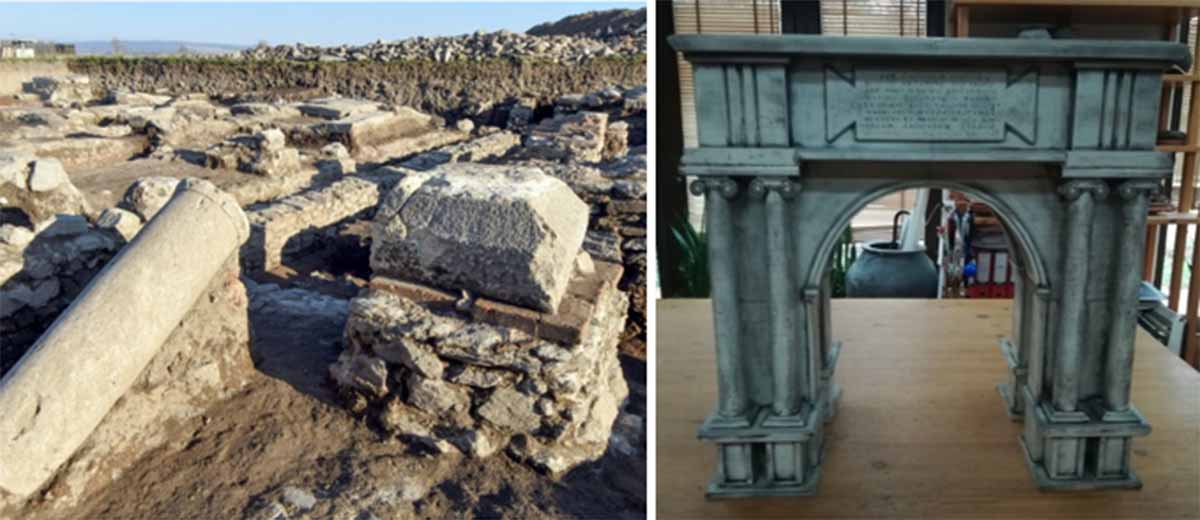Emperor Caracalla’s Triumphal Arch Unearthed in Serbia
A lesser-known fact about Serbia is that 17 Roman emperors were born in its territory, with Central Serbia being under Roman rule for 800 years. Evidence of this history was unearthed in December, when a triumphal arch was discovered at the archaeological site of Viminacium, an ancient Roman city located near the town of Kostolac, approximately 70 kilometers (45 miles) east of Belgrade. Dating to the third century, it is only one of a handful found in the whole of the Balkans.
First Triumphal Arch of the Era: Romans and the Triumph
The principal archaeologist and one of Serbia’s leading archaeologists, Miomir Korac, stated that the finding occurred while excavating the main thoroughfare of Viminacium, the capital of the Roman province of Moesia, reports Reuters. “This is the first such triumphal arch in this area… It can be dated to the first decades of the third century AD,” said Korac.
It is constructed in the style of a tetrapylon, a rectangular monument with arched passages, or, in this case with a singular passage and an inscription field positioned above the arched section. The arch has fundamental measurements of 10.40 by 6.25 meters (34.12 by 20.5 feet), dimensions which mirror those of the Arco dei Gavi triumphal arch in Verona, with a height of 12.70 meters (41.6 feet).
- How the Rise and Fall of the Roman Empire Shifted Populations
- 42-Foot Roman Ship Unearthed in Serbian Mine

Model of the Roman Imperial Arch found in Viminacium. (Serbia Archaeological Institute)
A significant clue pointing to its historical context came in the form of a marble slab fragment featuring the letters CAES/ANTO. This inscription suggested that the arch was dedicated to Emperor Marcus Aurelius Antoninus, also known as Caracalla, who held reign from 198 to 217 AD, says a report in a local Serbian newspaper.
Building on the already discovered artifacts, archaeologists concluded that the triumphal arch was constructed either toward the end of the second century or, at the latest, the early years of the third century AD.
“We were completely surprised when we discovered that one section of the main street of Viminacium was missing the roadway and its substructure. Instead of them, we came across a foundation foot in the shape of a square, built of massive pieces of limestone. We continued our excavations and discovered three more such feet! It became clear that these were the foundations of a tetrapylon, a building on four pillars, with passages on four sides. There was no doubt that it was one of the trademarks of Roman architecture: the triumphal arch or the triumphal arch,” says Dr. Saša Redžić, quoted by Arkeonews.
- Marcus Aurelius: Life of the Famous Roman Emperor and Philosopher
- The Five Good Emperors: Prosperity and Power Before the Final Fall

Arial image of the location in Viminacium where the Roman triumphal arch dedicated to Caracalla has been found. (Serbia Archaeological Institute)
Triumphal arches stand as iconic and influential examples of ancient Roman architecture. These structures were ingeniously crafted by the Romans, drawing upon their mastery of arch and vault construction.
Triumphal arches were designed to commemorate significant events and individuals in Roman society, including triumphant generals, the establishment of new colonies, the construction of roads or bridges, the passing of imperial family members, or the coronation of a new emperor. These architectural marvels served as enduring symbols of Roman power, triumph, and civic pride, leaving an indelible mark on the landscape of ancient Rome and beyond.
Emperor Caracalla and Excavating Viminacium: Significant in Roman History
The mystery surrounding the dedication of the triumphal gate was unraveled from the nearly frozen ground. Emperor Caracalla, who, having spent his formative years in military camps alongside his father Septimus Severus, actively engaged in battles from the age of 15.
Historical accounts reveal a momentous event in the capital of Upper Moesia, Viminacium: the proclamation of Marcus Aurelius Antoninus, more commonly known as Caracalla, as Caesar, ruler, and successor to his father Septimius Severus in 195. Three years later, he assumed the title of Augustus.
Researchers, aware of the arch's significance, established that it was erected to commemorate this pivotal event in the empire's history: the plaque merely confirmed this hunch.
In his statement to the local press, Dr. Ilija Danković said:
“The research plan meant that we first excavate the main Viminacium street – Decumanus. We located it and discovered a 10.4-meter-wide street paved with smooth stone then we came to an elaborate sewer network. The excavation confirmed that there were colonnades of columns on both sides of the street.”

More remains of the base of the triumphal arch. (Serbia Archaeological Institute)
Viminacium, also referred to as Viminatium, held prominence as a significant city and provincial capital within the Roman province of Moesia, situated in present-day Serbia. It served as the capital of Moesia Superior, encompassing a vast territory that extended across much of modern eastern Serbia, Kosovo, northeastern Albania, the northern regions of North Macedonia (Moesia Superior), the northern parts of Bulgaria, Romanian Dobruja, and minor segments of southern Ukraine (Moesia Inferior).
Excavations at Viminacium have been ongoing since 1882, yet archaeologists believe they have only scratched the surface, having explored a mere 5% of the expansive site. Spanning approximately 450 hectares, which surpasses the size of New York's Central Park, Viminacium is notably distinct for not being overshadowed by a modern city.
Findings from these excavations include two Roman ships, golden tiles, coins, jade sculptures, religious artifacts, mosaics, frescoes, weaponry, and even the remains of three mammoths.
Top image: The remains of the Roman triumphal arch found in Serbia. Source: Serbia Archaeological Institute.
By Sahir Pandey
References
Altuntas, L. 2024. Serbian Archaeologists Unearth Roman Triumphal Arch Dedicated to Emperor Caracalla. Available at: https://arkeonews.net/serbian-archaeologists-unearth-roman-triumphal-arch-dedicated-to-emperor-caracalla/.
Reuters. 2024. Remains of ancient Roman triumphal arch unearthed in Serbia. Available at: https://edition.cnn.com/2024/01/24/style/serbia-roman-triumphal-arch/index.html.

















